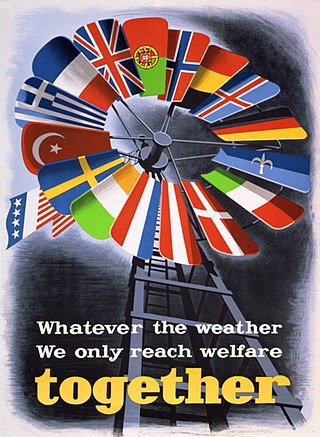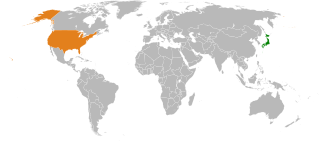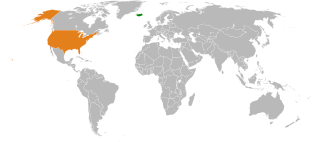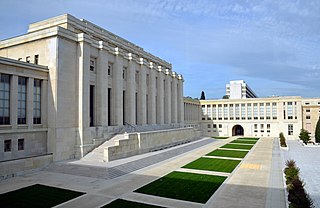
The spoke–hub distribution paradigm is a form of transport topology optimization in which traffic planners organize routes as a series of "spokes" that connect outlying points to a central "hub". Simple forms of this distribution/connection model contrast with point-to-point transit systems, in which each point has a direct route to every other point, and which modeled the principal method of transporting passengers and freight until the 1970s. Delta Air Lines pioneered the spoke–hub distribution model in 1955, and the concept revolutionized the transportation logistics industry after Federal Express demonstrated its value in the early 1970s. In the late 1970s the telecommunications and information technology sector subsequently adopted this distribution topology, dubbing it the star network network topology.
In international relations, multilateralism refers to an alliance of multiple countries pursuing a common goal.

Atlanticism, also known as Transatlanticism, is the ideology which advocates ever closer alliance between nations in Northern America and in Europe on political, economic, and defense issues. The purpose is to maintain or increase the security and prosperity of the participating countries and protect liberal democracy and the progressive values of an open society that unite them under multiculturalism. The term derives from the North Atlantic Ocean, which is bordered by North America and Europe.

Transatlantic relations refer to the historic, cultural, political, economic and social relations between countries on both side of the Atlantic Ocean. Sometimes it specifically means relationships between the Anglophone North American countries, and particular European countries or organizations, although other meanings are possible.

International relations between Japan and the United States began in the late 18th and early 19th century with the diplomatic but force-backed missions of U.S. ship captains James Glynn and Matthew C. Perry to the Tokugawa shogunate. Following the Meiji Restoration, the countries maintained relatively cordial relations. Potential disputes were resolved. Japan acknowledged American control of Hawaii and the Philippines, and the United States reciprocated regarding Korea. Disagreements about Japanese immigration to the U.S. were resolved in 1907. The two were allies against Germany in World War I.

Japan is a great power and a member of numerous international organizations, including the United Nations, the OECD, and the Group of Seven. Although it has renounced its right to declare war, the country maintains Self-Defense Forces that rank as one of the world's strongest militaries. After World War II, Japan experienced record growth in an economic miracle, becoming the second-largest economy in the world by 1990. As of 2021, the country's economy is the third-largest by nominal GDP and the fourth-largest by PPP.

The Department of Foreign Affairs is the executive department of the Philippine government tasked to contribute to the enhancement of national security, protection of the territorial integrity and national sovereignty, to participate in the national endeavor of sustaining development and enhancing the Philippines' competitive edge, to protect the rights and promote the welfare of Filipinos overseas and to mobilize them as partners in national development, to project a positive image of the Philippines, and to increase international understanding of Philippine culture for mutually-beneficial relations with other countries.
The San Francisco System is a network of alliances pursued by the United States in the Asia-Pacific region, after the end of World War II – the United States as a "hub", and Japan, South Korea, Taiwan, the Philippines, Thailand, Australia, and New Zealand as "spokes". The system is made of bilateral political-military and economic commitments between the United States and its Asia-Pacific allies. This system stands in contrast to a multilateral alliance, such as NATO.

The Sino-American Mutual Defense Treaty (SAMDT), formally Mutual Defense Treaty between the United States of America and the Republic of China, was a defense pact signed between the United States and the Republic of China (Taiwan) effective from 1955 to 1980. It was intended to defend the island of Taiwan from invasion by the People's Republic of China. Some of its content was carried over to the Taiwan Relations Act of 1979 after the failure of the Goldwater v. Carter lawsuit.

Victor D. Cha is an American academic, author and former national foreign policy advisor.

American–Uzbek relations formally began when the United States recognized the independence of Uzbekistan on December 25, 1991, and opened an embassy in Tashkent in March 1992. U.S.-Uzbekistan relations developed slowly and reached a peak following the U.S. decision to invade Afghanistan following the September 11, 2001 attacks. Relations cooled significantly following the "color revolutions" in the former Soviet republics of Georgia, Ukraine, and Kyrgyzstan in 2003–2005, and the Government of Uzbekistan sought to limit the influence of U.S. and other foreign non-governmental organizations (NGOs) working on civil society, political reform, and human rights inside the country.

The United States has maintained diplomatic relations with Iceland since the mid-1800s.

Bilateral relations between the Kingdom of Thailand and the United States of America date back to 1818. Thailand and the United States have long been close allies and diplomatic partners.

An international organization, also known as an intergovernmental organization or an international institution, is an organization that is established by a treaty, or is an instrument governed by international law and possessing its own legal personality, such as the United Nations, the World Health Organization, Save the Children International, International Union for Conservation of Nature, and NATO. International organizations are composed of primarily member states, but may also include other entities, such as other international organizations, firms, and nongovernmental organizations. Additionally, entities may hold observer status. An alternative definition is that an international organization is a stable set of norms and rules meant to govern the behavior of states and other actors in the international system.
U.S. President Barack Obama's East Asia Strategy (2009–2017), also known as the Pivot to Asia, represented a significant shift in the foreign policy of the United States since the 2010s. It shifted the country's focus away from the Middle Eastern and European sphere and allowed it to invest heavily and build relationships in East Asian and Southeast Asian countries, especially countries which are in close proximity to the People's Republic of China (PRC) either economically, geographically or politically to counter its rise as a rival superpower.

A commercial policy is a government's policy governing international trade. Commercial policy is an all encompassing term that is used to cover topics which involve international trade. Trade policy is often described in terms of a scale between the extremes of free trade on one side and protectionism on the other. A common commercial policy can sometimes be agreed by treaty within a customs union, as with the European Union's common commercial policy and in Mercosur. A nation's commercial policy will include and take into account the policies adopted by that nation's government while negotiating international trade. There are several factors that can affect a nation's commercial policy, all of which can affect international trade policies.

The most significant initiative made by the Narendra Modi government is the focus on neighbouring countries and major Asian powers coupled with emphasizing on the two decades old Look East policy. Asia being the major focus area of his foreign policy, Modi and his foreign minister chose several Asian countries for their initial bilateral visits. He has made state visits to Bhutan and Nepal and Japan within the first 100 days of his government and also hosted Asian leaders like former Prime Minister Tony Abbott of Australia, President Xi Jinping of China and Prime Minister Nguyễn Tấn Dũng of Vietnam, apart from inviting SAARC leaders in his inauguration ceremony. External Affairs Minister Sushma Swaraj has also made official visits to several Asian capitals like Dhaka, Bangladesh, Kathmandu, Nepal, Naypidaw, Myanmar, Singapore, Hanoi, Vietnam, Manama, Bahrain, Kabul, Afghanistan, Dushanbe, Tajikistan, Malé, Maldives, Abu Dhabi, United Arab Emirates, Seoul, South Korea and Beijing China.
US-China strategic engagement refers to a wide range of specific practices and interaction including economic cooperation, public diplomacy, military and foreign aid between the United States and China. This phase of engagement can be traced back to the late 1960s following an intense period of hostility caused by indirect confrontation between the two countries, particularly during the Korean War and the Vietnam War. With the US' support for Taiwan during the Taiwan Strait crises and its military expansion in the Pacific region, the relationship grew more antagonistic for the Chinese government perceive these initiatives to be US' attempt to encircle China. The domestic upheaval as a result of the Cultural Revolution in China and its commitment to communism through political radicalism accelerated the conflict. The four presidencies preceding the Bush administration were said to embrace a national policy direction toward strategic ambiguity, or deliberate ambiguity particularly in dealing with China. In October 2018, Vice President Mike Pence delivered a speech at the Hudson Institute on China, signifying the end of strategic engagement and officially proclaiming a new stage in the bilateral relationship, strategic competition.
A quasi-alliance is a relationship between two states that have not formed an alliance despite sharing a common ally. It is an informal security arrangement that is not based on a formal collective defence pact, but it is instead based on tacit agreements. It is unique from an alliance as the states do not have this formal collective defence pact. These two states may remain unallied due to alliance hindrances such as historical animosity, but still share a common, powerful ally capable of diminishing the two states' security fears; security fears caused by a common threat.













